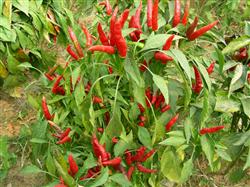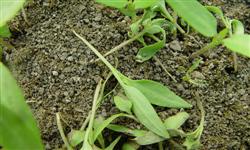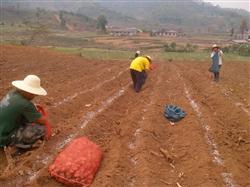How to plant chili peppers for high yield in summer?

How to plant chili peppers for high yield in summer? Please introduce the planting methods for planting chili peppers in summer can refer to the following methods: 1 variety selection over-summer cultivation of chili peppers is mainly supplied in summer and autumn, which is easy to cause diseases due to high temperature and humidity, resulting in reduced yield or even no harvest. Therefore, it is necessary to select mid-late and late-maturing pepper varieties with heat resistance, disease resistance, large fruit, good commercial characters and high yield, such as Zhengjiao 12, and some mid-maturing varieties with good resistance such as Zhengjiao Pioneer can also be selected. Such as foreign transportation, the selected varieties should also be thick and resistant to pressure, storage and transportation, such as Zhengjiao 16, Xiangjiao 37 and so on. (2) it takes 60 ~ 80 days from sowing and breeding to budding and flowering, but the time will be shortened in summer when the temperature is high. Those planted in succession with garlic and rape or interplanted with western (sweet) melons and wheat are generally sown and raised seedlings in mid-late March in the Central Plains, while those planted with wheat stubble are generally sown and raised seedlings in the first ten days of April. The nursery bed is set in the open field, but the temperature in the early stage of seedling cultivation is low, so it needs to be covered with a small arch shed and removed after the late frost. In order to reduce root injury, reduce non-growing period and prevent diseases, the method of one-time sowing is generally adopted, so it is necessary to sow sparsely. After emergence, the seedlings are planted for 2 or 3 times, and the seedlings are fixed when they have 1 or 2 true leaves and the distance between seedlings is about 12cm. The number of seedlings left in each hole varies according to the cultivation method. For those planted in succession with garlic, rape and wheat, 1 strong seedling was left in each hole, and 2 were left in melon and wheat intercropping. Seedlings with drought and water shortage should be irrigated in time, and a small amount of fertilizer can be applied to promote seedling growth. Water was watered once 1-2 days before planting to facilitate the emergence of seedlings with soil. (3) for planting and continuous planting of garlic, rape and wheat, rush harvest, ploughing and early planting should be achieved. After the previous crop is harvested, it is necessary to immediately kill stubble, fertilize, cultivated land, make beds, and plant. Because hot pepper is afraid of flooding, it should be cultivated in small and high beds. But instead of covering with plastic film, the seedlings are planted on both sides of the small high border near the shoulders of the ground to facilitate watering and drainage. Can be planted with equal line spacing, preferably wide and narrow rows, which is easy to manage. Wide row, pepper 70 ~ 80cm, sweet pepper 60cm; narrow row, pepper 50cm, sweet pepper 40cm. Due to the high temperature in summer, virus diseases are easy to occur, so over-summer pepper should be closely planted properly. Especially sweet pepper with high density, luxuriant branches and leaves and early ridge sealing can prevent sunburn, reduce ground temperature by 1 ~ 2 ℃, keep the ground moist and form a good field microclimate, which is beneficial to the normal growth and development of plants. Hole distance: pepper 33 ~ 40cm, single plant per hole; sweet pepper 25 ~ 33cm, two plants per hole. Before planting, 75t/hm2, superphosphate 750kg / hm2 and potassium sulfate 375kg / hm2 should be applied as base fertilizer. For interplanting with western (sweet) melon, early-maturing varieties should be selected and plastic film mulching cultivation should be carried out. The interplanting time of pepper seedlings can be arranged in about 30 days after sowing. Two rows of chili peppers were planted in each ridge, that is, one hole of pepper was planted on both sides of the ridge between two sweet melons. Intercropping with wheat, wheat is generally 2.0 ~ 2.2m in one belt, sowing 2 wheat, leaving 0.8 ~ 1.0m wide empty bed for planting hot pepper. Planted in the first and middle of May, two rows of chili pepper were planted in the empty border with 2 plants per hole (50cm), narrow row spacing (60cm) and wide row spacing (1.5 ~ 1.6 m). When planting, dig holes according to the distance between points to plant seedlings. Choose cloudy or sunny days after 3 pm to reduce the wilting of seedlings as far as possible. Water the seedling bed one day before seedling emergence, bring as much rooting soil as possible when raising seedlings, prevent scattered tuo when transporting seedlings, and minimize root injury. Cover the soil and water immediately after planting. In the slow seedling stage, continuous watering is needed for 2 or 3 times in order to reduce the soil temperature and accelerate the seedling retardation. (4) if the weather is dry after field management and planting, the seedling water should be irrigated in time. Application of diammonium phosphate 105 ~ 150kg / hm2 to promote early emergence of seedlings, but the amount of topdressing should not be large, too much would easily lead to overgrowth. After slowing down the seedlings, one intertillage should be carried out in time to break the soil consolidation, increase the oxygen uptake of the roots, promote strong seedlings and prevent overgrowth. The temperature in summer is relatively high, and the sandy loam should be watered once every 7 days when it does not rain. Cool well water should be watered in the evening. The field temperature can be reduced from high temperature to suitable with cool well water, and it still has a cooling effect in the next few days. It is not suitable to be watered when the temperature is high in the daytime. When the temperature is high, the temperature in the field rises quickly, and the pepper is prone to virus disease and so on. In the full fruit stage, it can be combined with watering and topdressing for 3 times, and urea or diammonium phosphate 150 ~ 300kg / hm2 is applied each time. In the early and middle stages of growth, ploughing and weeding should be carried out in time to cultivate the soil, and it is not suitable for ploughing after fruit setting, so as to avoid diseases. After the Autumn Equinox, the temperature gradually decreased, the fruit growth slowed down, pay attention to the topdressing of available fertilizer, combined with watering diammonium phosphate 225kg / hm2 or urea 150kg / hm2, and pay attention to foliar spraying potassium dihydrogen phosphate and trace element fertilizer to ensure the full growth of fruit in the later stage. In midsummer, the temperature is high, the air humidity is low, and the soil evaporation is large. In order to prevent excessive evaporation of soil moisture, rice straw or crop straw should be used to cover a layer on the surface of hot pepper border before closing, first, to reduce soil temperature, reduce ground water evaporation, play the role of water and fertilizer conservation; second, to prevent weeds; third, to reduce the impact of Rain Water on the border surface and prevent soil surface hardening. The suitable cover thickness is 3 ~ 4cm, too thin can not achieve the proper covering effect, too thick is not good for the ventilation of pepper, and it is easy to cause flower drop and fruit rot. (5) the door pepper should be harvested in time so as not to absorb nutrients, affect the fruit hanging of the plant and reduce the yield. Sweet peppers are usually green fruits on the market. The pepper should be harvested in time when the fruit is dark green, hard and bright. Some red fruits can also be harvested when the price of red fruit is high. If it is kept fresh in winter, the green fruit must be picked to prolong the shelf life. It should be harvested once before Frosts Descent. Click to get more chili planting techniques click to get more vegetable planting techniques
- Prev

How to control dead pepper seedlings with high temperature in summer
How to prevent and cure dead pepper seedlings with high temperature in summer? Please introduce the method in summer, high temperature and rainy climate conditions are very easy to induce a variety of pepper diseases. When it suddenly clears up after heavy rain, the climatic conditions of sudden rise in temperature are easy to cause disease epidemic, which can cause plant death within 3-5 days, that is, "dead trees". The disease is the destruction of chili.
- Next

How to apply base fertilizer and topdressing for planting Chinese yam?
How to apply base fertilizer and topdressing for planting Chinese yam? Please give guidance on the methods of planting yam, applying base fertilizer and topdressing can refer to the following methods: first, base fertilizer. Select a good field, before ploughing, apply mature farm manure 2000 kg-4000 kg, compound fertilizer 60 kg-80 kg as base fertilizer, and then plough the soil 30%.
Related
- Where is it suitable to grow horseradish in China? it is expected to see the middle altitude horseradish in Alishan.
- How to prevent tomato virus disease reasonably? (Control methods included)
- Many people like to plant towel gourd on the balcony. What are the main points of this method and management?
- What crops can chili peppers be mixed with?
- Fertilization techniques and matters needing attention in Tomato
- What are the grafting techniques for peach seedlings in spring?
- Harm and control methods of root swelling disease of Chinese cabbage
- What are the pests of sweet potatoes? How to prevent and cure it?
- Symptoms, causes and Control methods of navel Rot in Tomato
- The cause of "Cucumber rotten bibcock" in Farmers' planting Cucumber and its Control Plan

